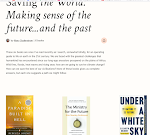Federal Environment Minister Jim Prentice put his foot in it this week when he
criticized Quebec's new auto emission standards as
being an “absolutely counter-productive and utterly pointless” way to cut greenhouse-gas emissions that will supposedly put Canada at a competitive disadvantage in the North American marketplace. "The(y) ensure consumers will basically have to leave that province to buy vehicles, to avoid levies of up to $5,000, because 75 per cent of the latest car and truck models don't conform to the new rules," he said
This is nonsense, of course. The Quebec regulations say that between now and 2016 the
province will require light vehicles sold in the province to progressively reduce greenhouse gas emissions until on average they produce no more than 127 grams of greenhouse gas per kilometre. The emission caps apply to a manufacturer's total vehicle fleet, which means companies that manage to come under the limit can either bank their credits, or sell them to others. And, as a spokesman for Quebec Environment Minister Line Beauchamp, pointed out, to meet the targets, all manufacturers have to do is sell more small vehicles.
Quebec and opposition politicians were quick to note, too, that Quebec is going along a path already pioneered by California, which has more vehicles than Canada as a whole anyway.
But what is forgotten in all this is that Canada's vehicles, on average, already do
better when it comes to fuel efficiency than what's proposed for California. A study done in 2008 showed that automobiles in Canada had an average fuel efficiency of 30 miles per US gallon (mpg), compared with an average of 25 mpg in the US and 23 mpg in California. But according to a voluntary agreement worked out by the Paul Martin government and the auto industry, the average was supposed to drop to 34 mpg by 2010, while the much-acclaimed California norms would only hit 33 mpg in 2016.
While fuel efficiency and cutting back on greenhouse gas emissions are not the same thing, they are linked. So what we have here is a lot of smoke (coming from car exhausts?) and mirrors (hooked to cars?) obscuring two points:
1) The current Stephen Harper government doesn't care about the enviroment, but does care about the petroleum industry. Their tactic is to attack with half truths to divert attention from what they're doing, which is moving away from any committment to environmental reform
2) Selling fewer motor vehicles, particularly fewer trucks and SUVs, will change the balance enormously. This means better public transport and more walkable, bikeable cities, but few people are talking about this side of the equation.
 We've had steady precipitation for the last few days--some rain, some snow with temperatures considerably warmer than usual for this time of year.
We've had steady precipitation for the last few days--some rain, some snow with temperatures considerably warmer than usual for this time of year.















